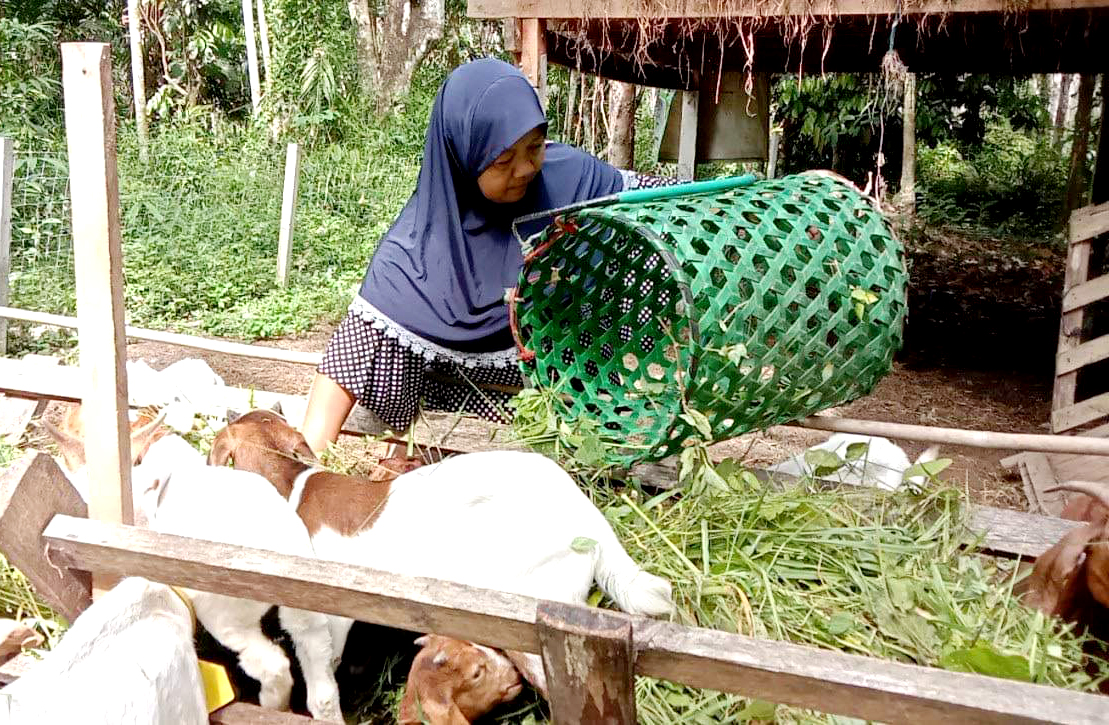กระบวนการยกระดับทุนการดำรงชีพอย่างยั่งยืนของกลุ่มเลี้ยงแพะหวะปันปัน น้ำตกมโนราห์ ตำบลคลองเฉลิม จังหวัดพัทลุง
Main Article Content
บทคัดย่อ
ตำบลคลองเฉลิม อำเภอกงหรา จังหวัดพัทลุง มีครัวเรือนยากจนร้อยละ 8.18 ที่ได้รับผลกระทบจากการแพร่ระบาดของโควิด-19 และการหดตัวของเศรษฐกิจ ซึ่งการแก้ปัญหาความยากจนอย่างยั่งยืนต้องใช้วิธีที่เหมาะสมกับแต่ละพื้นที่ ดังนั้นงานวิจัยนี้จึงใช้งานโมเดลการเลี้ยงแพะหวะเพื่อยกระดับทุนการดำรงชีพอย่างยั่งยืนกับครัวเรือนยากจน ด้วยกระบวนการดังนี้ 1) การสร้างแรงหนุนเสริมของผู้นำชุมชนและหน่วยงานภาครัฐ 2) การสร้างกลุ่มแบบมีโครงสร้าง โดยกำหนดบทบาทของคณะกรรมการบริหารกลุ่ม คนเลี้ยงแพะ และสมาชิก 3) การสร้างกฎกติการกลุ่ม สำหรับการบริหารกลุ่ม การสมัครสมาชิก การทำบัญชี การใช้งบประมาณ แหล่งเงินทุน การลงหุ้นและการรับผลประโยชน์ และสวัสดิการ 4) การสร้างเสริมทักษะอาชีพ ด้านทักษะการบริหารกลุ่ม การเลี้ยงแพะ การสร้างร้านออนไลน์ 5) การสร้างโรงเรือนเลี้ยงแพะ เพื่อให้เป็นไปตามมาตรฐานการปฏิบัติทางการเกษตรที่ดีสำหรับแพะเนื้อ และระบบการป้องกันโรคและการเลี้ยงสัตว์ที่เหมาะสม 6) การจัดการแปลงหญ้าและอาหารหมักสำหรับการเลี้ยงแพะ และ 7) การสร้างเครือข่ายการเลี้ยงแพะหวะ ส่งผลให้มีการจัดตั้งกลุ่มเลี้ยงแพะหวะปันปัน น้ำตกมโนราห์ โรงเรือนสำหรับเลี้ยงแพะ การระดมทุนเพื่อจัดซื้อแพะสำหรับเลี้ยงในฟาร์ม กฎกติกาในการดำเนินการ และการแบ่งผลประโยชน์ โดยรายได้จากผลประกอบการจะแบ่งผลประประโยชน์ให้กับคณะกรรมการบริหารร้อยละ 40 คนเลี้ยงแพะร้อยละ 40 และสมาชิกร้อยละ 20 นอกจากนี้ยังเป็นการสร้างอาชีพให้กับสมาชิกดังนี้ ตัวแทนจำหน่ายแพะ ปลูกหญ้าเป็นอาหารแพะ รับจ้างตัดหญ้าอาหารสัตว์ รับจ้างขนส่งแพะมีชีวิต และรับจ้างชำแหละแพะ ซึ่งเป็นการยกระดับทุนการดำรงชีพอย่างยั่งยืนสำหรับครัวเรือนยากจน
Article Details

อนุญาตภายใต้เงื่อนไข Creative Commons Attribution-NonCommercial-NoDerivatives 4.0 International License.
Area Based Development Research Journal values copyright protection and licensing to safeguard author rights and facilitate the appropriate dissemination of research. Our policies ensure openness, accessibility, and attribution. Authors retain copyright ownership, and articles are published under a Creative Commons Attribution License (CC BY), allowing sharing, adaptation, and proper attribution. Authors have the freedom to publish under the CC BY license, granting broad reuse and distribution permissions. The journal supports posting articles on third-party repositories, adhering to institutional and funding restrictions. Author guidelines detail copyright and licensing requirements, empowering authors with knowledge about their rights and responsibilities. These policies cultivate an environment of collaboration, openness, and responsible sharing, benefiting authors and the research community while honoring intellectual property rights.
เอกสารอ้างอิง
Cherdchom, P., Pakeechay, K., Intason, U., & Petsri, P. (2015). Trends in goat meat and mutton consumption in the Southernmost provinces. Songklanakarin Journal of Social Sciences and Humanities, 21(1), 201-222. (in Thai).
Government Gazette. (2006). Announcement of the National Agricultural Commodity and Food Standards Committee Subject: Establishment of national agricultural standards: Good agricultural practices for beef goat farms, B.E. 2006 (TSS 6004-2549).
Announced on 10 September 2006, Volume 123 Section 114 D, 26 October 2006. (in Thai).
Government Gazette. (2017). Department of Livestock Development Regulations Regarding obtaining and designing a farm certificate with appropriate protection and animal husbandry systems, B.E. 2017. Announced on 14 November 2017, Volume 134 Section 277 D, 26 October 2006. (in Thai).
Information and Communication Technology Center. (2021). Information on the number of farmers who raise animals and livestock for the year 2022. Retrieved on April 15, 2023, from: https://ict.dld.go.th/webnew/index.php/th/service-ict/report/396-report-thailand-livestock/reportservey2565/1711-province-2565. (in Thai).
Information and Communication Technology Center. (2022). Information on the number of farmers who raise animals and livestock for the year 2021 and 2022. Retrieved on April 15, 2023, from: https://ict.dld.go.th/webnew/index.php/th/service-ict/report/247-report-thailand-livestock. (in Thai).
Mattaphong, I. (2019). Study on the production, marketing and consumer behaviour of meat goats in the upper southern Thailand. (Master’s thesis). Prince of Songkla University, Faculty of Science in Agriculture Science and Technology. (in Thai).
Office of the National Economic and Social Development Council. (2022). Poverty and inequality report, 2021. Office of the National Economic and Social Development Council, Division of Information Development and Social Indicators. Office of the Prime Minister. (in Thai).
Sangthong, K., Noosen, P., & Ngampongsai, W. (2022). Effects of dietary protein levels in concentrate on growth performance and nutrient utilization of Thai indigenous male goat. Khon Kaen Agriculture Journal, 50(2), 448-459. (in Thai).
Semae, S. (2007). The success way of goat raising by muslim way. Journal of Yala Rajabhat University, 2(1), 72-81. (in Thai).
Sorabut, H., Jongrungrot, V., & Chanjula, P. (2021). Classification of farming system with raising meat goat in Satun province. Khon Kaen Agriculture Journal, 37(2), 227-241. (in Thai).
Tongkaemkaew, U., Wonglom, P., Kochapakdee, S., Somrup, S., Suwannarat, A., Amonwiriyachai, W., & Chusong, J. (2021). Social innovation of goat herders: Meat goat farm management in bank model by group of farmers affected by the COVID-19 pandemic in Tamot district, Phatthalung province. Parichart Journal, 35(1), 1-20. (in Thai).
Tongkaemkaew, U., Wonglom, P., Somrup, P., & Songsang, A. (2023). Assessment of meat goat shared farming by GFM and GAP standard under the sustainable self-reliance concept of farmers in Tamot district, Phatthalung province. Journal of Community Development and Life Quality, 11(2), 152-166. (in Thai).


